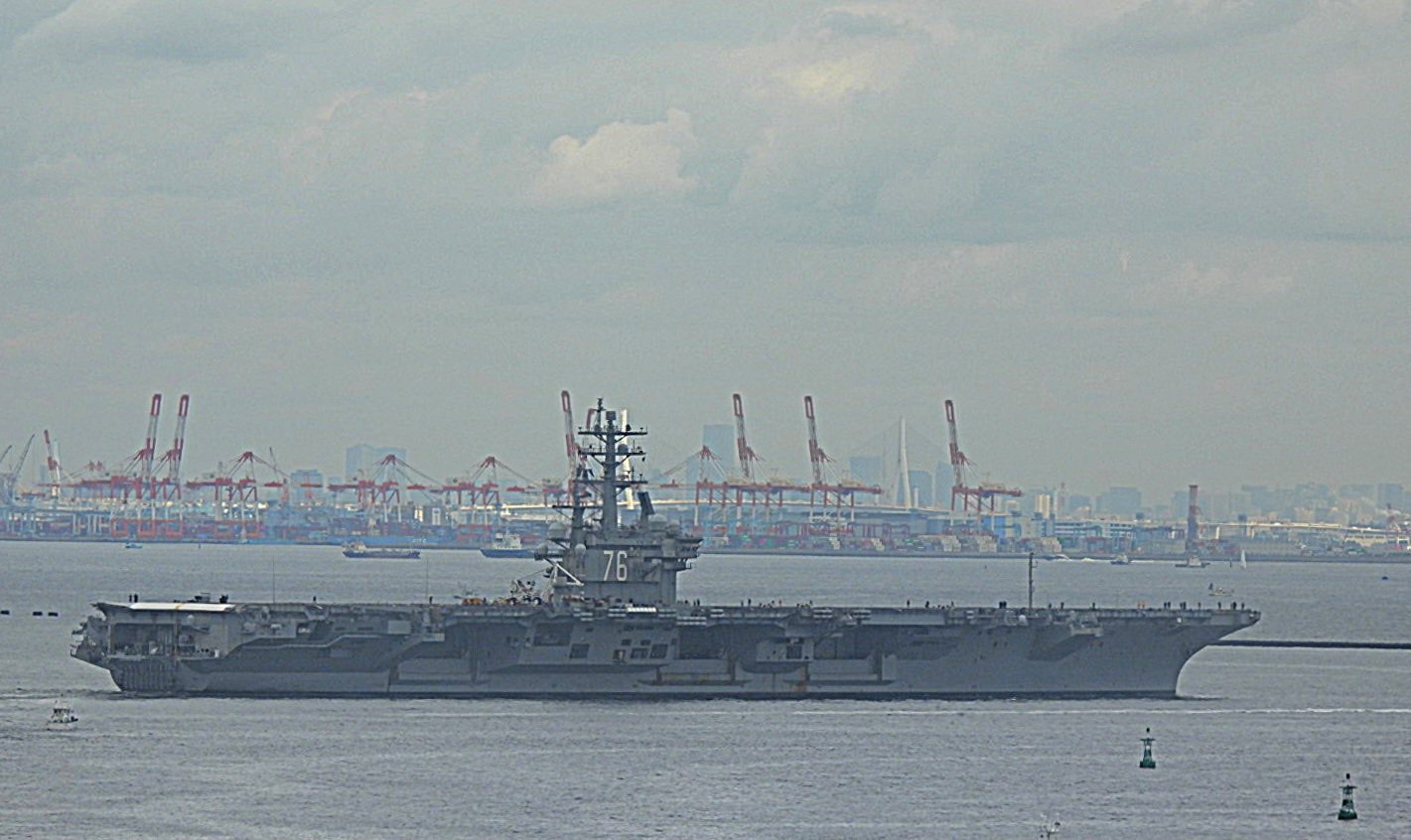
This post has been updated with a statement from U.S. 7th Fleet.
Carrier USS Ronald Reagan (CVN-76) got underway on Friday after canceling its departure six times since Sept. 18. Meanwhile, the Navy’s two Ghost Fleet unmanned surface vessel prototypes, which pulled into Yokosuka on Sept. 18, carried out drills on Wednesday with a U.S. Littoral Combat Ship and a Japan Maritime Self-Defense Force (JMSDF) frigate.
Reagan departed at 9.55 a.m. local time according to the Yokosuka city government. The Navy routinely informs the Japanese government of the departures and arrivals of U.S. nuclear-powered carriers at Japanese ports. The government, via the Ministry of Foreign Affairs, then informs the relevant city government, which publishes the information as a matter of public interest.
Reagan was originally scheduled to depart on Sept. 18 but the departure was postponed consecutively until Sept. 21, when it was announced that the departure was postponed to an undetermined date. The carrier was then scheduled to depart on Monday, Sept. 25 before being canceled again to an undetermined date. A Thursday departure was then postponed to Friday, when the carrier finally departed. In a statement to USNI News following a previous version of this post, a U.S. 7th Fleet spokesperson acknowledged the delays were the result of an unspecified mechanical issue.
“After pulling in to Yokosuka for regularly scheduled mid-deployment maintenance and personnel turnover, the USS Ronald Reagan crew determined additional maintenance was needed before returning to sea,” reads the statement. “USS Ronald Reagan departed Yokosuka on Sept. 29 and returned to sea to continue its deployment in support of a free and open Indo-Pacific.”
米国海軍の原子力空母「ロナルド・レーガン (USS Ronald Reagan, CVN-76) 」出港しました。頑張って。💪 pic.twitter.com/5UDscHIcGu
— MICHIYA MURATA (@MICHIYAM) September 29, 2023
Japanese shipspotter videos and photographs also showed cruiser USS Antietam (CG-54) departing Yokosuka after Reagan on the same day. Antietam and USS Robert Smalls (CG-62) are the only cruisers forward deployed to Japan following USS Shiloh’s (CG-67) departure for Pearl Harbor on Sept. 5. Robert Smalls, together with destroyer USS Shoup (DDG-86), carried out a multidomain bilateral exercise on Wednesday in the Sea of Japan with Republic of Korea Navy destroyers ROKS Yulgok Yi I (DDG-992) and ROKS Dae Joyeung (DDH-997) and fast combat support ship ROKS Cheonji (AOE-57), according to a Navy release.
The bilateral exercise included personnel exchanges, coordinated maneuvering, antisubmarine warfare drills and combined refueling operations. “Over the last 70 years, our alliance with the Republic of Korea has proven to be one of the strongest and most durable in modern history,” said Rear Adm. Pat Hannifin, Commander, Task Force 70 in the release. “Exercises like this allow our navies to not only maintain confidence in our ability to fight together as a unified force, but to get better, find efficiencies and continue innovating. Our bilateral navy team is more proficient and more powerful now than it’s ever been, and this exercise was a perfect chance to showcase that.”
On Wednesday, JMSDF frigate JS Kumano (FFM-2) carried out drills with littoral combat ship USS Oakland (LCS-24) and USVs Mariner and Ranger in Sagami Bay (which lies 24 miles southwest of Tokyo), according to a Friday JMSDF release. The drill marked the first time Japan has conducted an exercise with USVs. “I believe that the exercise together was a good opportunity to develop new ways to utilize surface vessels in the future and to strengthen cooperation between Japanese and the U.S. naval forces in the field of research and development of USV,” said Cmdr. Atsushi Izumi, Kumano’s commanding officer, in the release.
In other developments, Japan’s Ministry of Defense announced on Friday that Defense Minister Minoru Kihara will make his first official visit to the United States next week, meeting on Wednesday with Secretary of Defense Lloyd Austin at the Pentagon.
Kihara, who was appointed on Sept. 13 following a cabinet reshuffle, spoke with Austin on the phone on Thursday. According to a Japan Ministry of Defense (MOD) release, the two defense chiefs discussed strengthening U.S.-Japan deterrence and response capabilities, including effective counterstrike capabilities and advanced defense cooperation among Japan, the U.S. and Republic of Korea, in light of the current situation in North Korea. In a Friday press conference, Kihara gave few details on his agenda for the visit beyond strengthening U.S.-Japan cooperation, building trust and having a frank discussion on the security environment.
On Wednesday, the Armed Forces of the Philippines (AFP) issued a release stating that the Philippine Navy will host this year’s iteration of the Phillipine-U.S. Exercise Samasama from Oct. 2–13 at the Naval Forces Southern Luzon (NFSL) Area of Operations. The exercise will cover the fundamentals of antisubmarine warfare, antisurface warfare, antiair warfare and electronic warfare, according to the release. Exercises will focus on warfighting serials and the training also will further improve maritime integration and combined interoperability with the JMSDF, Royal Australian Navy (RAN), Royal Canadian Navy (RCN) and the Royal Navy (RN) through subject-matter expert exchanges and humanitarian assistance and disaster response table-top events. The French Navy and RAN will send personnel to join the subject-matter expert exchanges while the Royal New Zealand Navy and Indonesian Navy will be in the exercise as observers. The Philippines News Agency reported that participating ships include Philippine Navy frigate BRP Antonio Luna (FF-151), U.S Navy destroyer USS Dewey (DDG-105) and dry cargo ship USNS Wally Schirra (T-AKE-8), RN offshore patrol vessel HMS Spey (P234), RCN frigate HMCS Vancouver (FFH331) and the JMSDF destroyer JS Akebono (DD-108).





